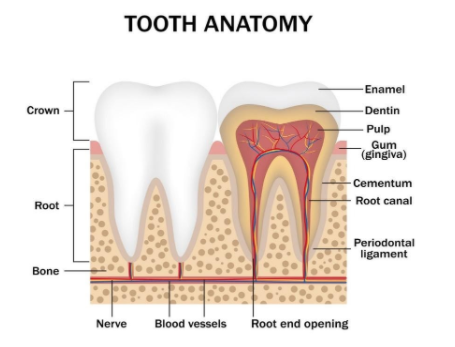
Answer
471.3k+ views
Hint: Enamel is the most mineralized tissue of the body, which is why it is considered to be the hardest calcified tissue of the body.
Complete answer:Enamel covers the entire anatomic crown of the tooth forming a translucent layer. It varies in thickness and hardness on each tooth and even from one person to another. It can also vary in color ranging from a yellowish tint to grayish white.
It is the enamel’s hardness that enables teeth to withstand blunt, heavy forces. Enamel is so hard as it mainly has inorganic materials: approximately 95% to 98% of it is calcium and phosphate ions that make up strong hydroxyapatite crystals.
However, these are not pure crystals, because they are carbonated and contain trace minerals such as strontium, magnesium, lead, and fluoride. Almost 1% to 2% of enamel has organic materials, particularly proteins called ‘enamelins’, which have a high affinity for binding the hydroxyapatite crystals. The remainder of enamel is made up of water (about 4% of its net composition).
Enamel is secreted by epithelial cells known as ameloblasts.
The ameloblasts are broken down when a tooth starts growing through the gums, removing enamel’s ability to regenerate or repair itself.
This implies that in case the enamel is damaged by any injury or decay, it can’t be restored.

So, the correct answer is A. Enamel.
Note:The enamel has no blood or nerve supply within it and it insulates us from feeling any kind of pain and sensitivity.
Complete answer:Enamel covers the entire anatomic crown of the tooth forming a translucent layer. It varies in thickness and hardness on each tooth and even from one person to another. It can also vary in color ranging from a yellowish tint to grayish white.
It is the enamel’s hardness that enables teeth to withstand blunt, heavy forces. Enamel is so hard as it mainly has inorganic materials: approximately 95% to 98% of it is calcium and phosphate ions that make up strong hydroxyapatite crystals.
However, these are not pure crystals, because they are carbonated and contain trace minerals such as strontium, magnesium, lead, and fluoride. Almost 1% to 2% of enamel has organic materials, particularly proteins called ‘enamelins’, which have a high affinity for binding the hydroxyapatite crystals. The remainder of enamel is made up of water (about 4% of its net composition).
Enamel is secreted by epithelial cells known as ameloblasts.
The ameloblasts are broken down when a tooth starts growing through the gums, removing enamel’s ability to regenerate or repair itself.
This implies that in case the enamel is damaged by any injury or decay, it can’t be restored.

So, the correct answer is A. Enamel.
Note:The enamel has no blood or nerve supply within it and it insulates us from feeling any kind of pain and sensitivity.
Recently Updated Pages
Fill in the blanks with suitable prepositions Break class 10 english CBSE

Fill in the blanks with suitable articles Tribune is class 10 english CBSE

Rearrange the following words and phrases to form a class 10 english CBSE

Select the opposite of the given word Permit aGive class 10 english CBSE

Fill in the blank with the most appropriate option class 10 english CBSE

Some places have oneline notices Which option is a class 10 english CBSE

Trending doubts
Fill the blanks with the suitable prepositions 1 The class 9 english CBSE

How do you graph the function fx 4x class 9 maths CBSE

Which are the Top 10 Largest Countries of the World?

What is the definite integral of zero a constant b class 12 maths CBSE

The Equation xxx + 2 is Satisfied when x is Equal to Class 10 Maths

Differentiate between homogeneous and heterogeneous class 12 chemistry CBSE

Define the term system surroundings open system closed class 11 chemistry CBSE

Full Form of IASDMIPSIFSIRSPOLICE class 7 social science CBSE

Change the following sentences into negative and interrogative class 10 english CBSE




